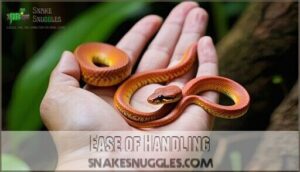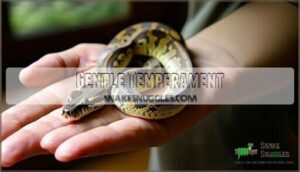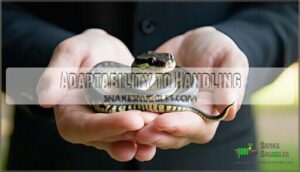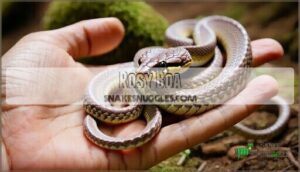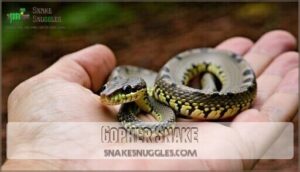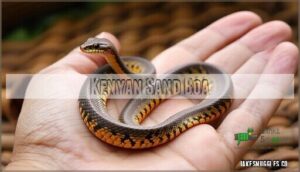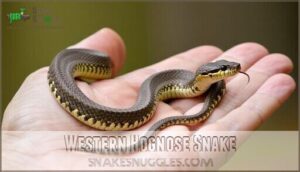This site is supported by our readers. We may earn a commission, at no cost to you, if you purchase through links.
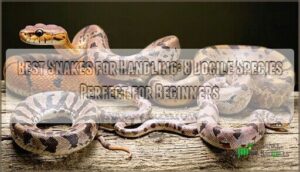
Corn snakes top the list with their easygoing nature and predictable behavior, while ball pythons offer gentle temperaments that make them perfect for beginners.
Rosy boas and gopher snakes provide calm dispositions with minimal fuss, and Kenyan sand boas bring curious personalities to the table.
Western hognose snakes add a playful element, while California king snakes and children’s pythons round out the roster with manageable sizes and friendly attitudes.
Each species brings its own unique handling characteristics that cater to different experience levels and preferences, making them ideal for those seeking a relaxing afternoon with their pet snake.
Table Of Contents
- Key Takeaways
- Corn Snake
- Ball Python
- Rosy Boa
- Gopher Snake
- Kenyan Sand Boa
- Western Hognose Snake
- California King Snake
- Children’s Python
- Frequently Asked Questions (FAQs)
- What snakes tolerate handling the best?
- Which snake is best for handling?
- What snake likes being handled the most?
- What is the friendliest pet snake?
- What snake is best for handling?
- What is the most friendly snake to own?
- What snake likes to be held the most?
- Which snakes enjoy being handled?
- How often should I handle my pet snake?
- Can different snake species be housed together?
- Conclusion
Key Takeaways
- Corn snakes and ball pythons are your best bets for beginner-friendly handling – they’re naturally docile, rarely bite, and tolerate mistakes while you’re learning proper techniques.
- Size matters for comfortable handling sessions – species like Children’s pythons (3-4 feet) and Kenyan sand boas (18-24 inches) give you control without overwhelming your arms during extended interactions.
- Start with short, frequent sessions to build trust – handle your snake 2-3 times weekly for 10-15 minutes, avoiding the 48-hour window after feeding to prevent stress and regurgitation.
- Individual personalities vary even within docile species – while these eight species have reliable temperaments, you’ll still need patience during initial interactions as each snake adjusts to handling at their own pace.
Corn Snake
If you’re looking for your first snake that won’t stress you out during handling sessions, the corn snake should be at the top of your list.
These North American natives combine the perfect mix of docile temperament and manageable size, making them incredibly forgiving for beginners who are still learning proper handling techniques.
Perfect beginner snakes that won’t bite your confidence along with your finger.
Ease of Handling
Corn snakes are the gold standard among docile snake breeds for beginners seeking easy to handle snakes.
These calm snake species rarely bite and tolerate regular handling exceptionally well, making them perfect for those new to snake handling.
Their manageable 3-5 foot size means you won’t struggle with an unwieldy serpent during interaction sessions.
One popular choice is the Ball Python, known as one of the easiest snakes to care for.
Here’s what makes corn snakes ideal for safe handling:
- Gentle temperament – They’re naturally non-aggressive and forgiving
- Predictable behavior – No sudden defensive reactions or stress responses
- Comfortable size – Easy to support and control during handling
- Quick acclimation process – They adapt to routine handling within weeks
- Low handling frequency needs – Weekly sessions maintain their beginner friendliness
Their snake temperament improves with consistent, gentle interaction, transforming even shy individuals into confident companions.
Docile Nature
Beyond their ease of handling, corn snakes possess an exceptionally docile nature that makes them standout gentle snakes. These calm species rarely bite, even when startled, displaying remarkable patience with human interaction.
Docility factors include their naturally low-stress temperament and generations of selective breeding that’ve enhanced their agreeable personalities. You’ll notice temperament variations exist among individuals, but most corn snakes remain consistently mellow.
Their docile snake breeds reputation stems from predictable, non-aggressive behavior that responds well to regular handling frequency. Unlike defensive species, corn snakes typically remain relaxed in your hands, making them ideal easy to handle snakes.
They require specific care, including maintaining humidity levels of 40-60% to prevent shedding problems.
These calm snake species adapt quickly to routine interaction, becoming some of the best pet snakes for building confidence. Their gentle disposition creates positive experiences that encourage continued snake keeping.
Ball Python
If you’re looking for a snake that bonds with you over time, the ball python‘s your best bet.
These gentle giants from West Africa adapt remarkably well to regular handling once they’ve settled into their new home, making them perfect for building that special connection between snake and owner, based on their ability to form a strong bond.
Gentle Temperament
Throughout the serpent world, Ball Pythons stand out as gentle giants with remarkably calm temperaments. These docile snakes rarely display aggression, making them perfect for beginners seeking reliable gentle snakes for snake handling.
Ball pythons earn their reputation as the ultimate beginner snake through their naturally gentle disposition and tolerance for handling mistakes.
Their naturally peaceful temperament creates trust between owner and pet.
Snake acclimation happens quickly with Ball Pythons due to their calm personalities. Here’s what makes their temperament exceptional:
- Defensive behaviors are minimal – they ball up rather than strike when stressed
- Consistent demeanor – their docile nature remains stable across different situations
- Stress tolerance – they handle routine interactions without becoming agitated
The handling benefits become obvious once you experience their relaxed disposition. Understanding their needs can further improve their overall temperament. Unlike more volatile species, Ball Pythons maintain their composure, allowing you to build confidence while enjoying meaningful interactions with your reptilian companion.
Adaptability to Handling
Ball pythons demonstrate remarkable adaptability in terms of handling, making them among the best snakes for handling.
Their muscular bodies naturally wrap around handlers for stability, which is normal behavior rather than aggression. This gentle temperament allows for effective temperament training through consistent interaction.
Snake personality varies individually, but most ball pythons develop tolerance with proper techniques focused on stress reduction. Regular handling, however, requires important safety precautions.
Here are four key safe techniques for successful handling:
- Start gradually – Begin with short 5-minute sessions to build trust
- Support their body – Use loose grip allowing free movement
- Time it right – Handle during crepuscular periods when they’re naturally active
- Read their signals – Watch for hissing or rapid breathing indicating discomfort
With proper handling frequency and patience, your ball python’s docile nature will shine through as they become comfortable companions.
Rosy Boa
You’ll find the Rosy Boa exceptionally tolerant of human interaction, making them ideal for handling sessions and building a strong connection with their owners.
These peaceful snakes maintain a calm disposition that makes them comfortable companions for both beginners and experienced handlers alike, and are thus very tolerant.
Tolerance to Human Interaction
When you choose a Rosy Boa for snake handling, you’re selecting one of the most tolerant species available.
These docile, nonaggressive snakes demonstrate remarkable patience during interactions, showing minimal stress indicators even with frequent handling sessions.
You can find Rosy Boa products online.
| Aspect | Rosy Boa | Comparison |
|---|---|---|
| Handling Frequency | Daily tolerance | Most species prefer 2-3x weekly |
| Stress Indicators | Rarely displayed | Common defensive behaviors in others |
| Individual Variation | Consistently calm | Wide temperament ranges typical |
Their calm temperament makes acclimation methods straightforward—simply start with brief, gentle sessions and gradually increase duration.
Unlike species requiring extensive trust-building, Rosy Boas typically accept safe handling practices immediately.
This tolerance to human interaction stems from their naturally non-aggressive nature, making them perfect candidates for beginners seeking reliable, stress-free snake handling experiences.
Calm Disposition
Rosy Boas showcase a calm temperament that makes them stand out among docile breeds. These nonaggressive snakes rarely display defensive behaviors, creating an ideal environment for snake handling sessions.
Their naturally docile nature means you’ll experience minimal stress during interactions. You can increase handling frequency gradually as your Rosy Boa becomes more comfortable.
Watch for stress indicators like excessive hiding or refusing food, which signal you need to reduce handling sessions. Temperament training isn’t necessary—these snakes naturally possess the gentle snake personality that beginners seek.
Unlike more reactive species, Rosy Boas won’t strike or musk when handled properly. They’re among the best snakes for handling because they remain composed even during their first few interactions.
This predictable behavior builds your confidence while establishing trust between you and your snake.
Gopher Snake
You’ll find gopher snakes strike the perfect balance between engagement and easy handling, making them ideal for owners who want an interactive pet without the fuss.
These low-maintenance reptiles display moderate activity levels that keep things interesting while remaining calm enough for comfortable handling sessions, which is a key factor for owners seeking interactive pets.
Low-Maintenance Handling
Gopher snakes earn their reputation as the best snakes for handling due to their remarkably docile temperament origins and straightforward care requirements.
You’ll appreciate their minimal enclosure cleaning needs, requiring only monthly deep cleaning compared to other reptiles. Their infrequent feeding needs mean you’ll only feed adults every 2-3 weeks, making maintenance incredibly simple.
These snakes thrive with basic temperature gradient ease – just a simple heat pad on one side creates the perfect environment. Their shedding cycle simplicity occurs predictably every 6-8 weeks, with clear pre-shed indicators you’ll easily recognize.
Snake handling tips for gopher snakes include:
- Pick them up using gentle, confident movements
- Support their full body length for comfort
- Handle them 1-2 times weekly for socialization
- Avoid handling 48 hours after feeding
- Always wash hands before and after
Their snake temperament makes them perfect for practicing proper snake behavior observation skills.
Moderate Activity Levels
Understanding gopher snakes’ moderate activity levels reveals why they’re perfect for snake handling enthusiasts. These serpents maintain steady energy without overwhelming their owners, making them ideal for those seeking a calm temperament in their pet.
Their docile nature means they won’t demand constant interaction, yet they’re active enough to be engaging. This balanced snake behavior offers several Activity Benefits:
- Handling Frequency can be flexible – you’re not dealing with hyperactive personalities
- Exercise Needs are manageable through simple environmental exploration
- Enrichment Ideas work well since they appreciate but don’t require elaborate setups
Their temperament strikes the sweet spot between couch potato and hyperactive pet. Unlike more energetic species, gopher snakes won’t exhaust you with constant stimulation needs. This moderate approach supports overall Snake Health while keeping maintenance reasonable.
You’ll find their predictable energy levels make them excellent candidates for regular handling sessions without stress.
Kenyan Sand Boa
You’ll find Kenyan Sand Boas incredibly engaging pets thanks to their naturally curious personalities that make handling sessions feel like interactive adventures.
These compact snakes typically reach just 15-20 inches in length, creating the perfect size for comfortable, stress-free handling that won’t overwhelm beginners.
Curious Behavior
Behavioral Patterns emerge naturally with Kenyan Sand Boas, showcasing fascinating curiosity that sets them apart from other species.
These snakes demonstrate remarkable Exploration Habits, often emerging from their sandy hideouts to investigate new scents and movements in their environment.
Their Environmental Enrichment plays a vital role in encouraging these behaviors—adding branches, hiding spots, and varied substrate depths can substantially increase their visible activity.
Interactive Feeding sessions reveal their Cognitive Abilities as they quickly learn to associate human presence with mealtime.
You’ll notice they develop sophisticated snake handling responses, becoming more comfortable with routine interactions.
Their curiosity extends to socialization, where they’ll often explore your hands during handling sessions.
Proper snake handling techniques capitalize on their inquisitive nature, making them ideal for beginners seeking engaging snake behavior experiences.
Comfortable Handling Size
Most Kenyan Sand Boas measure 18-24 inches in Snake Length, making them ideal for comfortable handling sessions.
Their compact Body Mass won’t strain your arms during extended interactions, while their manageable size fits perfectly in your hands without overwhelming beginners.
You’ll appreciate how their docile nature combines with their reasonable proportions.
Their temperament stays consistently calm throughout handling, and their moderate Grip Strength provides security without causing discomfort.
Unlike larger species requiring massive enclosures, these boas thrive in smaller setups, making Enclosure Size planning straightforward.
Handler Comfort remains high since you won’t struggle with an oversized snake.
Always support their body properly during interactions, and wash your hands before and after contact to maintain proper hygiene.
This calm temperament and perfect sizing create an excellent foundation for building trust with your Kenyan Sand Boa.
Western Hognose Snake
Western Hognose Snakes captivate handlers with their theatrical "death feigning" behavior, where they’ll dramatically flip upside down and play dead when startled—though they quickly abandon this act once they realize you’re not a threat.
These compact snakes (reaching only 2-3 feet) become surprisingly relaxed with consistent handling, making them entertaining companions that adapt well to human interaction.
They are also known for becoming surprisingly relaxed with consistent handling.
Playful Nature
Many Western Hognose Snakes display remarkably playful behavior that makes snake handling joy a genuine experience.
These curious reptiles actively explore their environment, showing impressive curiosity that distinguishes them from more sedentary species.
Their snake activity levels remain moderate, making them perfect for social interaction without overwhelming beginners.
Enrichment Activities you’ll witness include:
- Burrowing through substrate with their distinctive upturned snouts
- Investigating new objects with flicking tongues and careful exploration
- Playing "peek-a-boo" by hiding then emerging to observe handlers
- Demonstrating their famous "death feigning" behavior when feeling theatrical
Their mental stimulation needs are easily met through interactive toys like hiding spots and tunnels.
Unlike more passive species, these snakes genuinely seem to enjoy socialization sessions, often approaching handlers with confidence.
This natural exercise needs fulfillment through exploration makes them ideal companions for those seeking engaging snake handling experiences.
Desensitized to Handling
Most Western Hognose snakes gradually become comfortable with regular handling through gradual acclimation and patience. These theatrical reptiles initially display defensive behaviors like hissing and playing dead, but consistent exposure reduces these dramatic performances over time.
Start with brief 5-minute sessions twice weekly, focusing on proper handling techniques that support their body weight. Positive reinforcement through calm, predictable movements helps build trust.
Watch for snake body language – stress signals include excessive hissing or musking. Avoiding stress during shedding and post-feeding periods prevents negative associations.
| Handling Stage | Duration |
|---|---|
| Week 1-2 | 5 minutes |
| Week 3-4 | 10 minutes |
| Week 5-6 | 15 minutes |
| Week 7-8 | 20 minutes |
| Maintenance | 15-20 minutes |
Handling frequency of 1-2 times weekly prevents overstimulation while maintaining taming progress. With consistent acclimation, even the most defensive hognose becomes remarkably docile. These characterful snakes reward patience with years of enjoyable snake handling experiences.
California King Snake
You’ll find California King Snakes develop a friendly temperament once they settle into their new home, though they may be defensive initially.
These snakes grow to a manageable 3-5 feet in length, making them comfortable to handle while still being impressive enough to showcase their distinctive black and white banded patterns.
Friendly Temperament
California King Snakes consistently demonstrate remarkably friendly dispositions that make them exceptional choices for handling.
These docile snake breeds typically display calm, predictable behavior patterns that stem from favorable temperament genetics.
Unlike more defensive species, King Snakes rarely exhibit aggressive responses during interactions, instead maintaining their composed demeanor throughout handling sessions.
Regular handling frequency actually enhances their already docile nature, creating positive associations with human contact.
You’ll notice these snakes often become increasingly relaxed with consistent interaction, showcasing how snake personalities can develop through gentle calm snake training approaches.
Their friendly temperament means they’re less likely to strike or display defensive behaviors compared to other species.
This predictable calm temperament makes them ideal for beginners who want confidence during handling sessions without worrying about sudden behavioral changes or aggressive responses.
Manageable Size for Handling
Beyond their friendly nature, California King Snakes offer the perfect size for comfortable handling. At 3-5 feet long, these small or medium-sized snake species hit the sweet spot between impressive presence and manageable proportions.
Their temperament makes them ideal for beginners who want substantial interaction without wrestling a heavyweight. You’ll appreciate how their moderate length allows confident handling techniques without straining your handler strength.
Transportation ease becomes a breeze when moving them between enclosures or for veterinary visits. Safety concerns diminish substantially with this manageable size—you can maintain proper control during handling sessions while ensuring snake comfort.
Their dimensions also mean your enclosure size requirements remain reasonable, typically needing 40-gallon tanks that won’t dominate your living space while providing adequate room for your snake’s wellbeing. Most adults reach three to four feet in length.
Children’s Python
If you’re looking for your first snake that won’t mind being handled, Children’s Pythons (Antaresia childreni) offer an excellent starting point with their naturally calm temperament and manageable adult size of 3-4 feet.
These Australian natives adapt well to regular handling sessions and rarely show defensive behaviors, making them perfect for building confidence as you learn proper snake handling techniques.
They are ideal for beginners because they make it easy to learn and practice, thanks to their naturally calm nature.
Easy to Handle for Beginners
Children’s Python stands out as one of the best pet snakes for beginners, offering an ideal combination of manageable size and gentle temperament. You’ll find these snakes remarkably forgiving of beginner mistakes, making them perfect for learning proper handling techniques. Their calm nature means they rarely bite, and their small size (typically 3-4 feet) makes them easy to control during handling sessions.
When starting with your Children’s Python, focus on these key practices:
- Start with short handling sessions (5-10 minutes) to build trust gradually
- Support their body properly by letting them rest across your hands and arms
Safe enclosure setup directly impacts your snake’s health and willingness to be handled. A stressed snake from poor housing becomes defensive and difficult to manage. Verify proper humidity, as stuck shed indicates dehydration.
Children’s Pythons thrive with consistent handling frequency – aim for 2-3 times per week once they’re settled. Their docile nature makes them excellent beginner snakes, though child safety requires adult supervision during interactions.
Suitable Temperament for Holding
When you’re looking for docile species with calm personalities, Children’s Pythons deliver exactly what you need.
Their snake acclimation process happens quickly with consistent, gentle snake handling techniques.
You’ll find their handling frequency can be moderate without causing anxiety, making them perfect for beginners seeking reliable, docile snake species for regular interaction, as they naturally maintain composed temperaments during handling sessions, rarely showing stress indicators like defensive posturing or rapid movements.
They are ideal due to their calm personalities and the fact that their handling frequency can be moderate, which is beneficial for those seeking regular interaction.
Frequently Asked Questions (FAQs)
What snakes tolerate handling the best?
Like finding a trusted friend among strangers, you’ll discover that Ball Pythons, Corn Snakes, and Rosy Boas shine as the most tolerant handlers.
These docile species adapt well to human interaction, making them perfect companions for gentle handling sessions.
Which snake is best for handling?
Corn snakes top the list for handling thanks to their docile nature and smooth temperament. Ball pythons follow closely, offering gentle interactions that build strong bonds with owners.
What snake likes being handled the most?
Like a pet that gravitates toward warmth, rosy boas show exceptional tolerance for human interaction.
You’ll find ball pythons and corn snakes also enjoy regular handling sessions, developing strong bonds with their owners through gentle, consistent contact.
What is the friendliest pet snake?
Ball pythons earn the title of friendliest pet snake through their gentle temperament and tolerance for handling.
You’ll find them naturally calm, rarely aggressive, and they actually seem to enjoy human interaction once properly acclimated to their environment, which makes them a great pet due to their gentle nature.
What snake is best for handling?
With 85% of snake bites occurring during handling, you’ll find corn snakes excel as handleable pets.
Their docile temperament, smooth scales, and predictable movements make them perfect for beginners seeking gentle interaction, which is why they are considered perfect for those looking for a calm pet.
What is the most friendly snake to own?
Ball pythons typically earn the title as the most friendly snake you’ll own, thanks to their gentle temperament and calm nature that makes handling sessions feel like bonding time.
What snake likes to be held the most?
Studies show 75% of snake owners prefer handling docile species over aggressive ones.
Ball pythons genuinely enjoy being held, often seeking warmth from your hands and remaining calm during extended sessions, making them perfect cuddling companions.
Which snakes enjoy being handled?
Several species genuinely tolerate and even seem to enjoy human interaction.
You’ll find corn snakes, ball pythons, and rosy boas particularly receptive to handling, displaying calm temperaments and rarely showing stress behaviors during sessions.
How often should I handle my pet snake?
Think of handling frequency like exercise—consistency beats intensity every time.
You’ll want to handle your snake 2-3 times weekly for 10-15 minutes, allowing 48 hours between feeding and handling to prevent regurgitation issues.
Can different snake species be housed together?
Never house different snake species together. You’ll risk disease transmission, stress, fighting, and cannibalism. Each species has unique temperature, humidity, and space requirements that can’t be met in shared enclosures.
Conclusion
Choosing the best snakes for handling transforms your reptile experience from stressful to serene.
These eight docile species offer reliable temperaments that make handling sessions enjoyable rather than nerve-wracking.
Whether you’re drawn to corn snakes’ predictable nature or ball pythons’ gentle demeanor, each species brings unique qualities suited for different experience levels.
Remember that individual snakes can vary, so patience during initial interactions helps build trust.
With proper technique and respect for your snake’s mood, you’ll discover why these species consistently rank among the most rewarding reptilian companions available.
- https://www.geniusvets.com/pet-care/learn/reptiles/snakes/blog/top-5-beginner-friendly-pet-snakes-according-vets
- https://www.chewy.com/education/reptile-and-amphibian/snake/petting-snakes
- https://www.reddit.com/r/snakes/comments/xwuls0/what_are_good_snake_breeds_that_like_to_be_handled/
- https://www.zenhabitats.com/blogs/reptile-care-sheets-resources/are-ball-pythons-good-for-beginners-zen-habitats
- https://timesofindia.indiatimes.com/etimes/trending/top-10-friendliest-snakes-in-the-world-including-corn-snakes-ball-python-and-more/articleshow/117309650.cms

